Cultural Theories Impact on China's National Culture: A Report
VerifiedAdded on 2020/07/22
|11
|3361
|83
Report
AI Summary
This report provides a comprehensive analysis of Chinese culture, exploring its national characteristics, personal cultural identity, and the influence of various cultural theories. The report delves into Hofstede's five cultural dimensions, particularly focusing on long-term orientation and its impact on Chinese society and business practices. It also examines the concepts of high and low context cultures and time orientation within the Chinese context. The report further discusses the relationship between national culture and business etiquette in China, highlighting key aspects such as relationship building and decision-making processes. The author reflects on how these cultural factors have personally influenced their understanding of working environments and societal values. Overall, the report offers valuable insights into the complexities of Chinese culture and its implications for business and personal interactions.
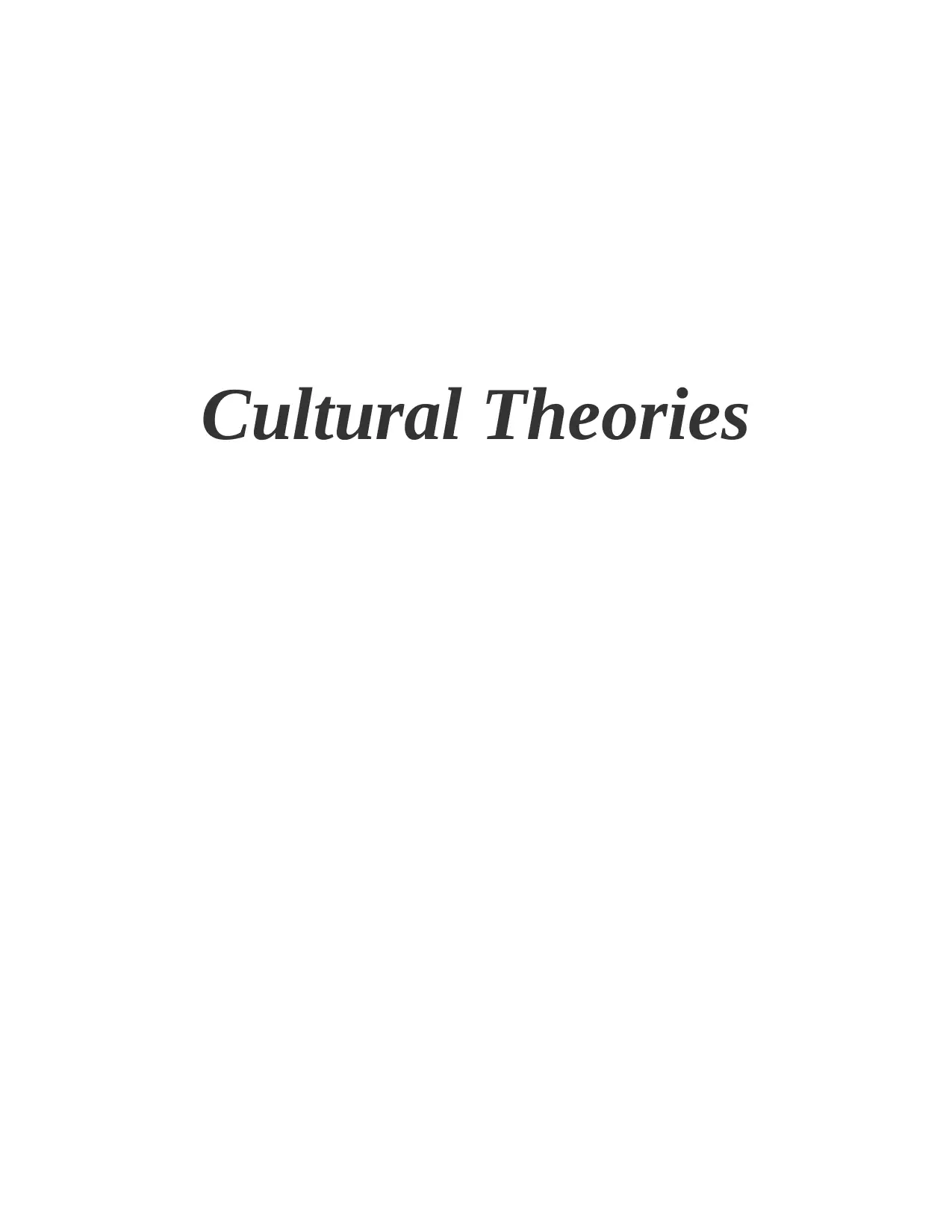
Cultural Theories
Paraphrase This Document
Need a fresh take? Get an instant paraphrase of this document with our AI Paraphraser
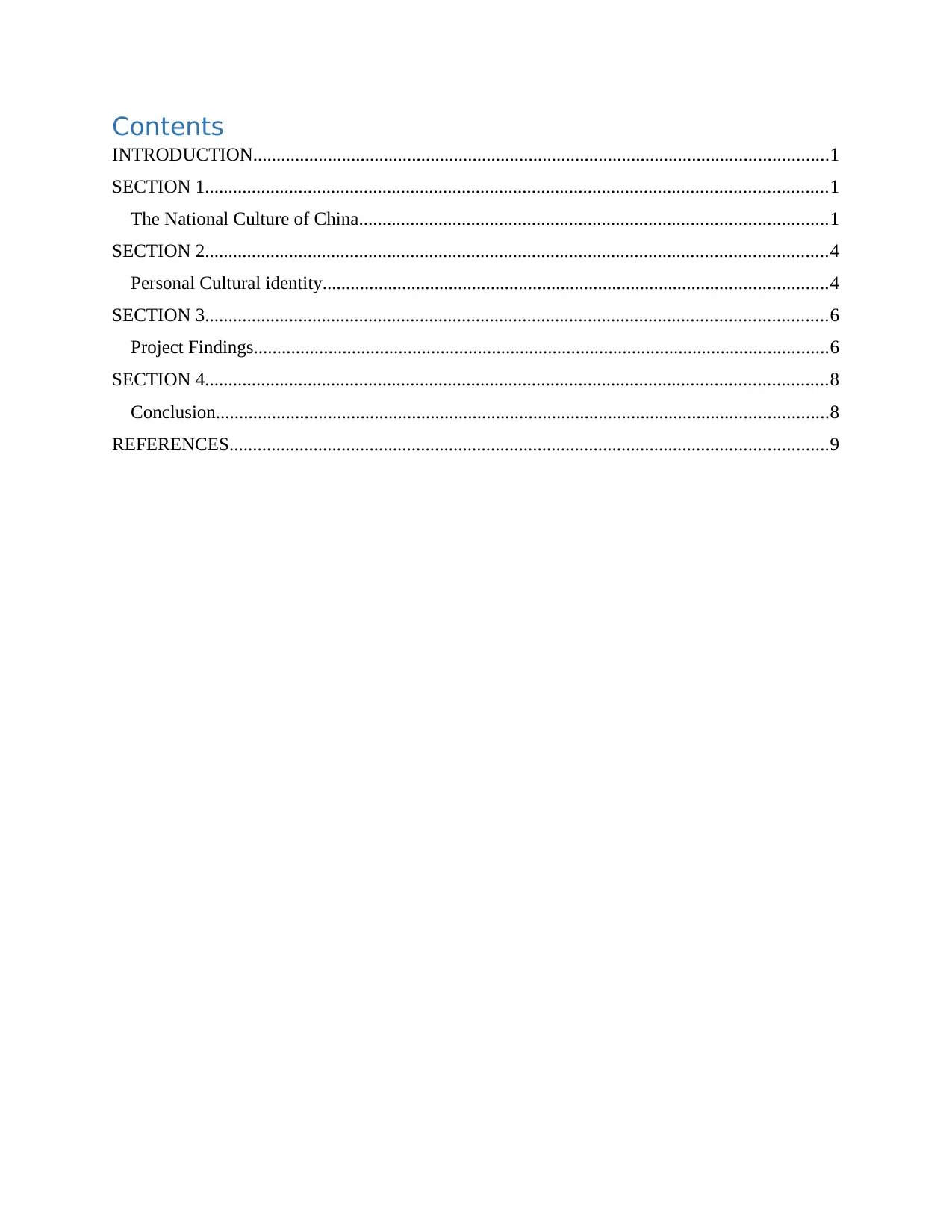
Contents
INTRODUCTION...........................................................................................................................1
SECTION 1.....................................................................................................................................1
The National Culture of China....................................................................................................1
SECTION 2.....................................................................................................................................4
Personal Cultural identity............................................................................................................4
SECTION 3.....................................................................................................................................6
Project Findings...........................................................................................................................6
SECTION 4.....................................................................................................................................8
Conclusion...................................................................................................................................8
REFERENCES................................................................................................................................9
INTRODUCTION...........................................................................................................................1
SECTION 1.....................................................................................................................................1
The National Culture of China....................................................................................................1
SECTION 2.....................................................................................................................................4
Personal Cultural identity............................................................................................................4
SECTION 3.....................................................................................................................................6
Project Findings...........................................................................................................................6
SECTION 4.....................................................................................................................................8
Conclusion...................................................................................................................................8
REFERENCES................................................................................................................................9
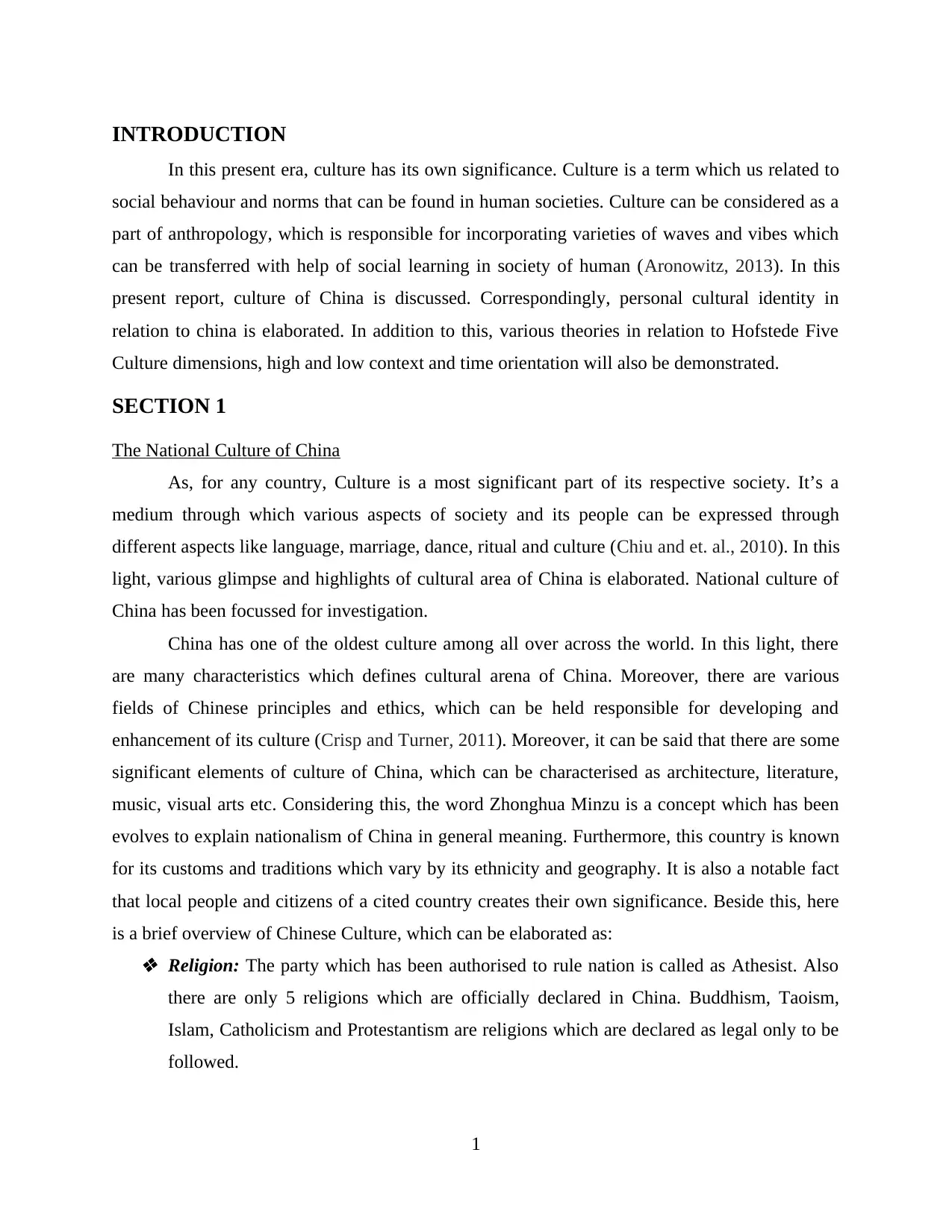
INTRODUCTION
In this present era, culture has its own significance. Culture is a term which us related to
social behaviour and norms that can be found in human societies. Culture can be considered as a
part of anthropology, which is responsible for incorporating varieties of waves and vibes which
can be transferred with help of social learning in society of human (Aronowitz, 2013). In this
present report, culture of China is discussed. Correspondingly, personal cultural identity in
relation to china is elaborated. In addition to this, various theories in relation to Hofstede Five
Culture dimensions, high and low context and time orientation will also be demonstrated.
SECTION 1
The National Culture of China
As, for any country, Culture is a most significant part of its respective society. It’s a
medium through which various aspects of society and its people can be expressed through
different aspects like language, marriage, dance, ritual and culture (Chiu and et. al., 2010). In this
light, various glimpse and highlights of cultural area of China is elaborated. National culture of
China has been focussed for investigation.
China has one of the oldest culture among all over across the world. In this light, there
are many characteristics which defines cultural arena of China. Moreover, there are various
fields of Chinese principles and ethics, which can be held responsible for developing and
enhancement of its culture (Crisp and Turner, 2011). Moreover, it can be said that there are some
significant elements of culture of China, which can be characterised as architecture, literature,
music, visual arts etc. Considering this, the word Zhonghua Minzu is a concept which has been
evolves to explain nationalism of China in general meaning. Furthermore, this country is known
for its customs and traditions which vary by its ethnicity and geography. It is also a notable fact
that local people and citizens of a cited country creates their own significance. Beside this, here
is a brief overview of Chinese Culture, which can be elaborated as: Religion: The party which has been authorised to rule nation is called as Athesist. Also
there are only 5 religions which are officially declared in China. Buddhism, Taoism,
Islam, Catholicism and Protestantism are religions which are declared as legal only to be
followed.
1
In this present era, culture has its own significance. Culture is a term which us related to
social behaviour and norms that can be found in human societies. Culture can be considered as a
part of anthropology, which is responsible for incorporating varieties of waves and vibes which
can be transferred with help of social learning in society of human (Aronowitz, 2013). In this
present report, culture of China is discussed. Correspondingly, personal cultural identity in
relation to china is elaborated. In addition to this, various theories in relation to Hofstede Five
Culture dimensions, high and low context and time orientation will also be demonstrated.
SECTION 1
The National Culture of China
As, for any country, Culture is a most significant part of its respective society. It’s a
medium through which various aspects of society and its people can be expressed through
different aspects like language, marriage, dance, ritual and culture (Chiu and et. al., 2010). In this
light, various glimpse and highlights of cultural area of China is elaborated. National culture of
China has been focussed for investigation.
China has one of the oldest culture among all over across the world. In this light, there
are many characteristics which defines cultural arena of China. Moreover, there are various
fields of Chinese principles and ethics, which can be held responsible for developing and
enhancement of its culture (Crisp and Turner, 2011). Moreover, it can be said that there are some
significant elements of culture of China, which can be characterised as architecture, literature,
music, visual arts etc. Considering this, the word Zhonghua Minzu is a concept which has been
evolves to explain nationalism of China in general meaning. Furthermore, this country is known
for its customs and traditions which vary by its ethnicity and geography. It is also a notable fact
that local people and citizens of a cited country creates their own significance. Beside this, here
is a brief overview of Chinese Culture, which can be elaborated as: Religion: The party which has been authorised to rule nation is called as Athesist. Also
there are only 5 religions which are officially declared in China. Buddhism, Taoism,
Islam, Catholicism and Protestantism are religions which are declared as legal only to be
followed.
1
⊘ This is a preview!⊘
Do you want full access?
Subscribe today to unlock all pages.

Trusted by 1+ million students worldwide
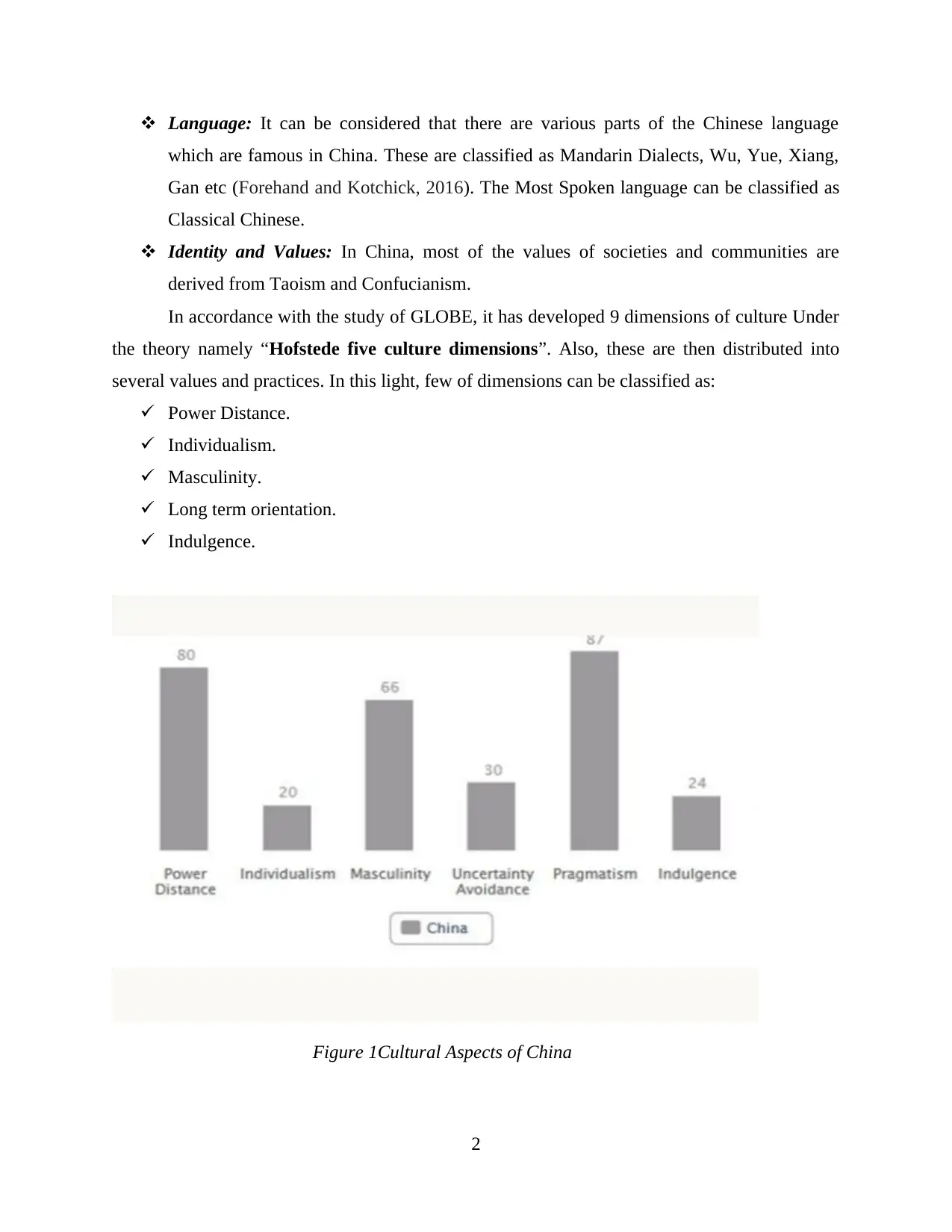
Language: It can be considered that there are various parts of the Chinese language
which are famous in China. These are classified as Mandarin Dialects, Wu, Yue, Xiang,
Gan etc (Forehand and Kotchick, 2016). The Most Spoken language can be classified as
Classical Chinese.
Identity and Values: In China, most of the values of societies and communities are
derived from Taoism and Confucianism.
In accordance with the study of GLOBE, it has developed 9 dimensions of culture Under
the theory namely “Hofstede five culture dimensions”. Also, these are then distributed into
several values and practices. In this light, few of dimensions can be classified as:
Power Distance.
Individualism.
Masculinity.
Long term orientation.
Indulgence.
Figure 1Cultural Aspects of China
2
which are famous in China. These are classified as Mandarin Dialects, Wu, Yue, Xiang,
Gan etc (Forehand and Kotchick, 2016). The Most Spoken language can be classified as
Classical Chinese.
Identity and Values: In China, most of the values of societies and communities are
derived from Taoism and Confucianism.
In accordance with the study of GLOBE, it has developed 9 dimensions of culture Under
the theory namely “Hofstede five culture dimensions”. Also, these are then distributed into
several values and practices. In this light, few of dimensions can be classified as:
Power Distance.
Individualism.
Masculinity.
Long term orientation.
Indulgence.
Figure 1Cultural Aspects of China
2
Paraphrase This Document
Need a fresh take? Get an instant paraphrase of this document with our AI Paraphraser
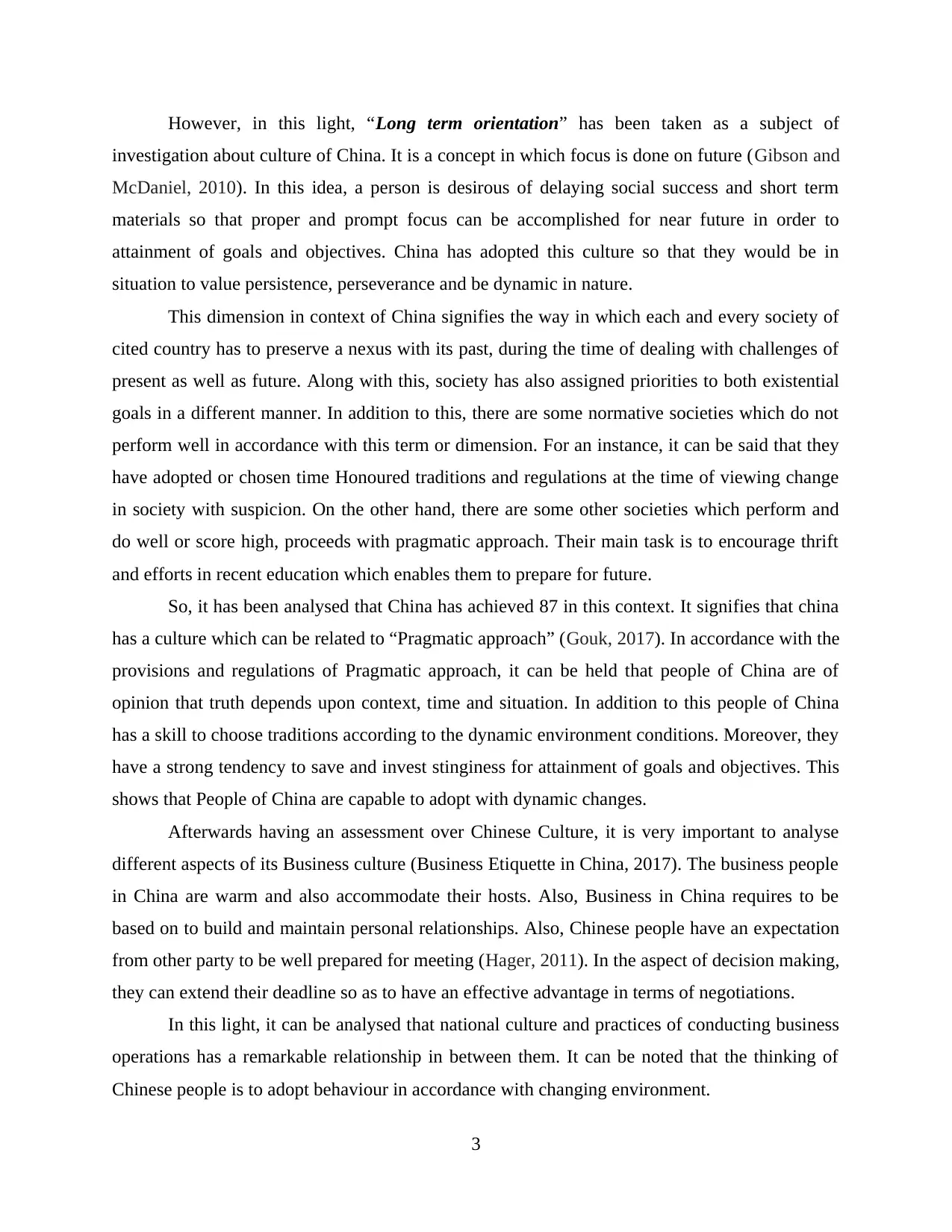
However, in this light, “Long term orientation” has been taken as a subject of
investigation about culture of China. It is a concept in which focus is done on future (Gibson and
McDaniel, 2010). In this idea, a person is desirous of delaying social success and short term
materials so that proper and prompt focus can be accomplished for near future in order to
attainment of goals and objectives. China has adopted this culture so that they would be in
situation to value persistence, perseverance and be dynamic in nature.
This dimension in context of China signifies the way in which each and every society of
cited country has to preserve a nexus with its past, during the time of dealing with challenges of
present as well as future. Along with this, society has also assigned priorities to both existential
goals in a different manner. In addition to this, there are some normative societies which do not
perform well in accordance with this term or dimension. For an instance, it can be said that they
have adopted or chosen time Honoured traditions and regulations at the time of viewing change
in society with suspicion. On the other hand, there are some other societies which perform and
do well or score high, proceeds with pragmatic approach. Their main task is to encourage thrift
and efforts in recent education which enables them to prepare for future.
So, it has been analysed that China has achieved 87 in this context. It signifies that china
has a culture which can be related to “Pragmatic approach” (Gouk, 2017). In accordance with the
provisions and regulations of Pragmatic approach, it can be held that people of China are of
opinion that truth depends upon context, time and situation. In addition to this people of China
has a skill to choose traditions according to the dynamic environment conditions. Moreover, they
have a strong tendency to save and invest stinginess for attainment of goals and objectives. This
shows that People of China are capable to adopt with dynamic changes.
Afterwards having an assessment over Chinese Culture, it is very important to analyse
different aspects of its Business culture (Business Etiquette in China, 2017). The business people
in China are warm and also accommodate their hosts. Also, Business in China requires to be
based on to build and maintain personal relationships. Also, Chinese people have an expectation
from other party to be well prepared for meeting (Hager, 2011). In the aspect of decision making,
they can extend their deadline so as to have an effective advantage in terms of negotiations.
In this light, it can be analysed that national culture and practices of conducting business
operations has a remarkable relationship in between them. It can be noted that the thinking of
Chinese people is to adopt behaviour in accordance with changing environment.
3
investigation about culture of China. It is a concept in which focus is done on future (Gibson and
McDaniel, 2010). In this idea, a person is desirous of delaying social success and short term
materials so that proper and prompt focus can be accomplished for near future in order to
attainment of goals and objectives. China has adopted this culture so that they would be in
situation to value persistence, perseverance and be dynamic in nature.
This dimension in context of China signifies the way in which each and every society of
cited country has to preserve a nexus with its past, during the time of dealing with challenges of
present as well as future. Along with this, society has also assigned priorities to both existential
goals in a different manner. In addition to this, there are some normative societies which do not
perform well in accordance with this term or dimension. For an instance, it can be said that they
have adopted or chosen time Honoured traditions and regulations at the time of viewing change
in society with suspicion. On the other hand, there are some other societies which perform and
do well or score high, proceeds with pragmatic approach. Their main task is to encourage thrift
and efforts in recent education which enables them to prepare for future.
So, it has been analysed that China has achieved 87 in this context. It signifies that china
has a culture which can be related to “Pragmatic approach” (Gouk, 2017). In accordance with the
provisions and regulations of Pragmatic approach, it can be held that people of China are of
opinion that truth depends upon context, time and situation. In addition to this people of China
has a skill to choose traditions according to the dynamic environment conditions. Moreover, they
have a strong tendency to save and invest stinginess for attainment of goals and objectives. This
shows that People of China are capable to adopt with dynamic changes.
Afterwards having an assessment over Chinese Culture, it is very important to analyse
different aspects of its Business culture (Business Etiquette in China, 2017). The business people
in China are warm and also accommodate their hosts. Also, Business in China requires to be
based on to build and maintain personal relationships. Also, Chinese people have an expectation
from other party to be well prepared for meeting (Hager, 2011). In the aspect of decision making,
they can extend their deadline so as to have an effective advantage in terms of negotiations.
In this light, it can be analysed that national culture and practices of conducting business
operations has a remarkable relationship in between them. It can be noted that the thinking of
Chinese people is to adopt behaviour in accordance with changing environment.
3
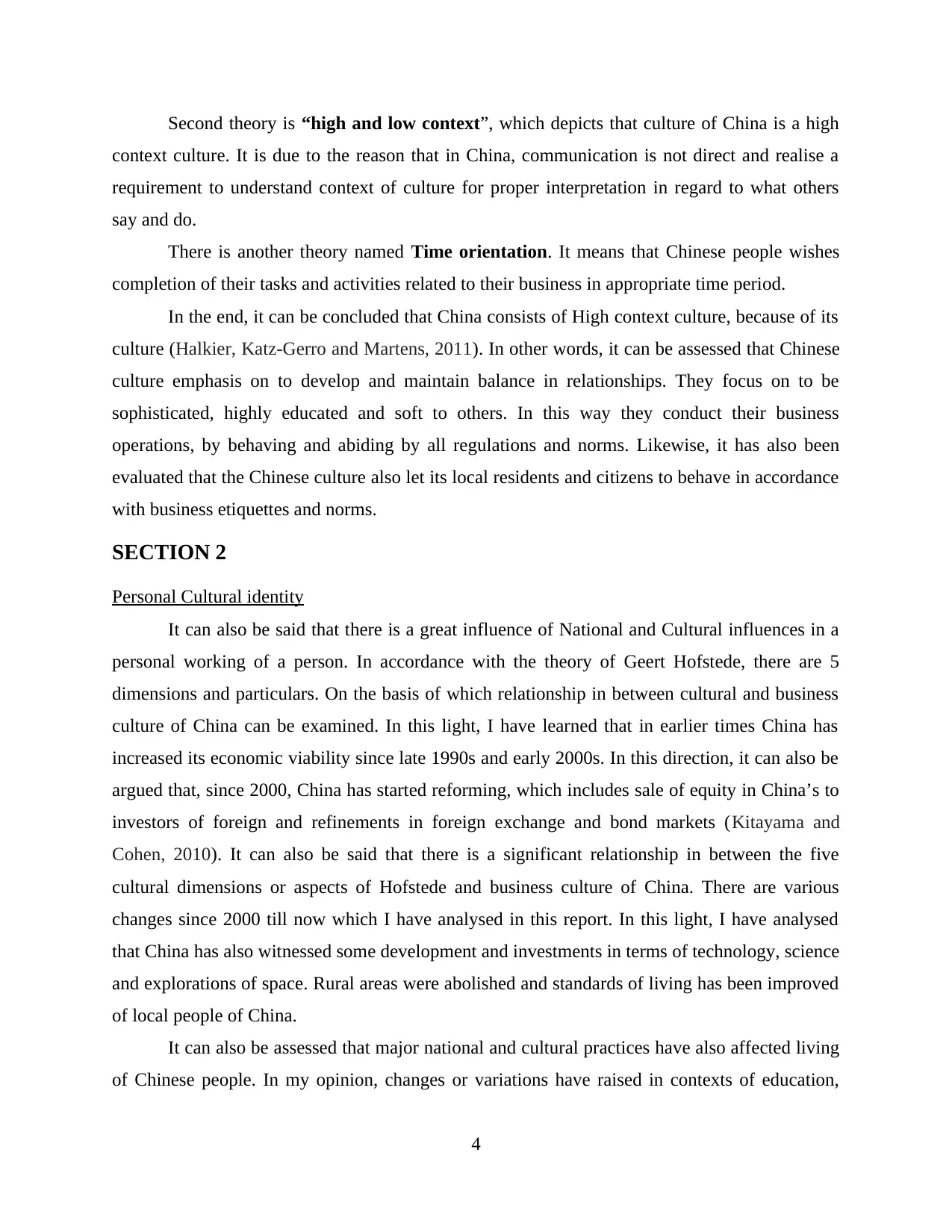
Second theory is “high and low context”, which depicts that culture of China is a high
context culture. It is due to the reason that in China, communication is not direct and realise a
requirement to understand context of culture for proper interpretation in regard to what others
say and do.
There is another theory named Time orientation. It means that Chinese people wishes
completion of their tasks and activities related to their business in appropriate time period.
In the end, it can be concluded that China consists of High context culture, because of its
culture (Halkier, Katz-Gerro and Martens, 2011). In other words, it can be assessed that Chinese
culture emphasis on to develop and maintain balance in relationships. They focus on to be
sophisticated, highly educated and soft to others. In this way they conduct their business
operations, by behaving and abiding by all regulations and norms. Likewise, it has also been
evaluated that the Chinese culture also let its local residents and citizens to behave in accordance
with business etiquettes and norms.
SECTION 2
Personal Cultural identity
It can also be said that there is a great influence of National and Cultural influences in a
personal working of a person. In accordance with the theory of Geert Hofstede, there are 5
dimensions and particulars. On the basis of which relationship in between cultural and business
culture of China can be examined. In this light, I have learned that in earlier times China has
increased its economic viability since late 1990s and early 2000s. In this direction, it can also be
argued that, since 2000, China has started reforming, which includes sale of equity in China’s to
investors of foreign and refinements in foreign exchange and bond markets (Kitayama and
Cohen, 2010). It can also be said that there is a significant relationship in between the five
cultural dimensions or aspects of Hofstede and business culture of China. There are various
changes since 2000 till now which I have analysed in this report. In this light, I have analysed
that China has also witnessed some development and investments in terms of technology, science
and explorations of space. Rural areas were abolished and standards of living has been improved
of local people of China.
It can also be assessed that major national and cultural practices have also affected living
of Chinese people. In my opinion, changes or variations have raised in contexts of education,
4
context culture. It is due to the reason that in China, communication is not direct and realise a
requirement to understand context of culture for proper interpretation in regard to what others
say and do.
There is another theory named Time orientation. It means that Chinese people wishes
completion of their tasks and activities related to their business in appropriate time period.
In the end, it can be concluded that China consists of High context culture, because of its
culture (Halkier, Katz-Gerro and Martens, 2011). In other words, it can be assessed that Chinese
culture emphasis on to develop and maintain balance in relationships. They focus on to be
sophisticated, highly educated and soft to others. In this way they conduct their business
operations, by behaving and abiding by all regulations and norms. Likewise, it has also been
evaluated that the Chinese culture also let its local residents and citizens to behave in accordance
with business etiquettes and norms.
SECTION 2
Personal Cultural identity
It can also be said that there is a great influence of National and Cultural influences in a
personal working of a person. In accordance with the theory of Geert Hofstede, there are 5
dimensions and particulars. On the basis of which relationship in between cultural and business
culture of China can be examined. In this light, I have learned that in earlier times China has
increased its economic viability since late 1990s and early 2000s. In this direction, it can also be
argued that, since 2000, China has started reforming, which includes sale of equity in China’s to
investors of foreign and refinements in foreign exchange and bond markets (Kitayama and
Cohen, 2010). It can also be said that there is a significant relationship in between the five
cultural dimensions or aspects of Hofstede and business culture of China. There are various
changes since 2000 till now which I have analysed in this report. In this light, I have analysed
that China has also witnessed some development and investments in terms of technology, science
and explorations of space. Rural areas were abolished and standards of living has been improved
of local people of China.
It can also be assessed that major national and cultural practices have also affected living
of Chinese people. In my opinion, changes or variations have raised in contexts of education,
4
⊘ This is a preview!⊘
Do you want full access?
Subscribe today to unlock all pages.

Trusted by 1+ million students worldwide
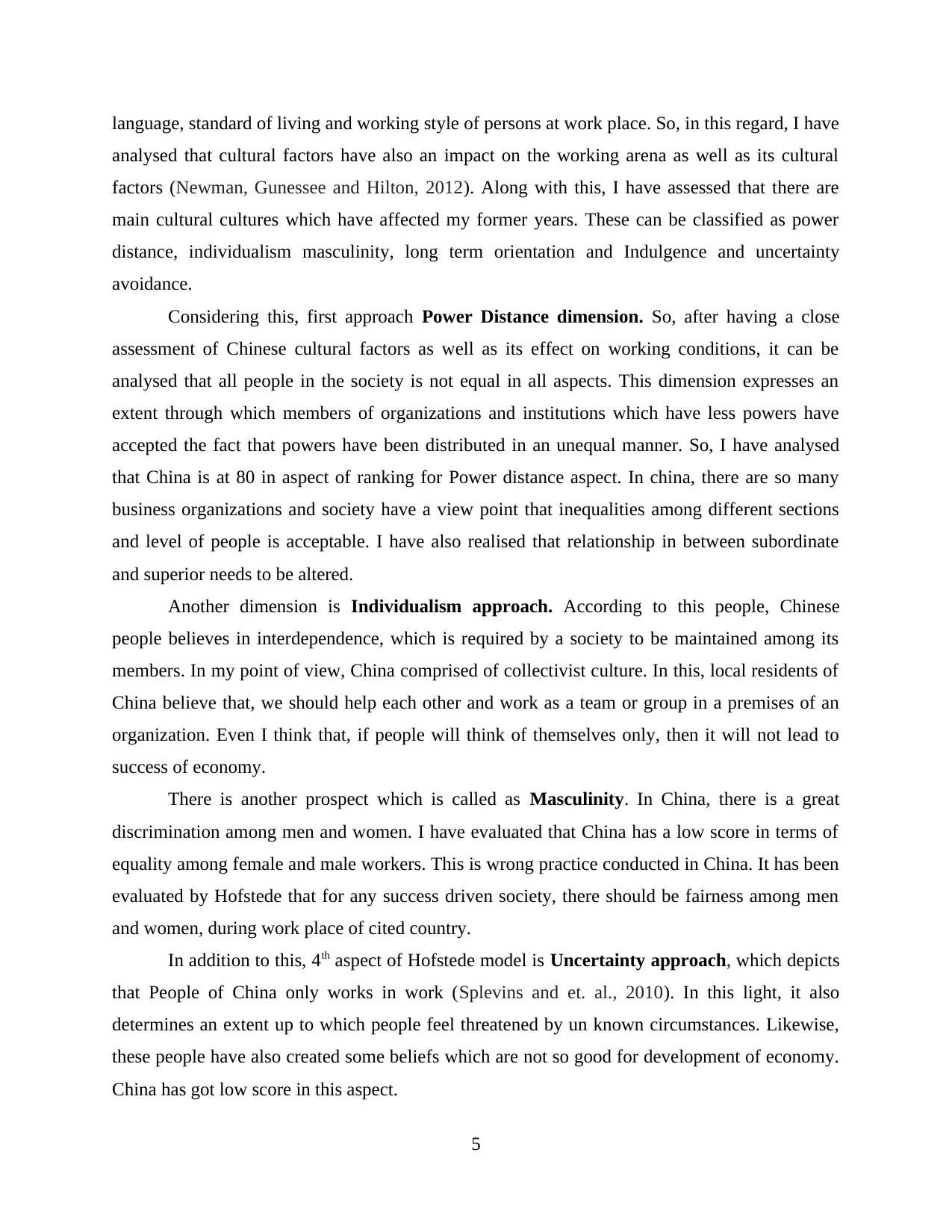
language, standard of living and working style of persons at work place. So, in this regard, I have
analysed that cultural factors have also an impact on the working arena as well as its cultural
factors (Newman, Gunessee and Hilton, 2012). Along with this, I have assessed that there are
main cultural cultures which have affected my former years. These can be classified as power
distance, individualism masculinity, long term orientation and Indulgence and uncertainty
avoidance.
Considering this, first approach Power Distance dimension. So, after having a close
assessment of Chinese cultural factors as well as its effect on working conditions, it can be
analysed that all people in the society is not equal in all aspects. This dimension expresses an
extent through which members of organizations and institutions which have less powers have
accepted the fact that powers have been distributed in an unequal manner. So, I have analysed
that China is at 80 in aspect of ranking for Power distance aspect. In china, there are so many
business organizations and society have a view point that inequalities among different sections
and level of people is acceptable. I have also realised that relationship in between subordinate
and superior needs to be altered.
Another dimension is Individualism approach. According to this people, Chinese
people believes in interdependence, which is required by a society to be maintained among its
members. In my point of view, China comprised of collectivist culture. In this, local residents of
China believe that, we should help each other and work as a team or group in a premises of an
organization. Even I think that, if people will think of themselves only, then it will not lead to
success of economy.
There is another prospect which is called as Masculinity. In China, there is a great
discrimination among men and women. I have evaluated that China has a low score in terms of
equality among female and male workers. This is wrong practice conducted in China. It has been
evaluated by Hofstede that for any success driven society, there should be fairness among men
and women, during work place of cited country.
In addition to this, 4th aspect of Hofstede model is Uncertainty approach, which depicts
that People of China only works in work (Splevins and et. al., 2010). In this light, it also
determines an extent up to which people feel threatened by un known circumstances. Likewise,
these people have also created some beliefs which are not so good for development of economy.
China has got low score in this aspect.
5
analysed that cultural factors have also an impact on the working arena as well as its cultural
factors (Newman, Gunessee and Hilton, 2012). Along with this, I have assessed that there are
main cultural cultures which have affected my former years. These can be classified as power
distance, individualism masculinity, long term orientation and Indulgence and uncertainty
avoidance.
Considering this, first approach Power Distance dimension. So, after having a close
assessment of Chinese cultural factors as well as its effect on working conditions, it can be
analysed that all people in the society is not equal in all aspects. This dimension expresses an
extent through which members of organizations and institutions which have less powers have
accepted the fact that powers have been distributed in an unequal manner. So, I have analysed
that China is at 80 in aspect of ranking for Power distance aspect. In china, there are so many
business organizations and society have a view point that inequalities among different sections
and level of people is acceptable. I have also realised that relationship in between subordinate
and superior needs to be altered.
Another dimension is Individualism approach. According to this people, Chinese
people believes in interdependence, which is required by a society to be maintained among its
members. In my point of view, China comprised of collectivist culture. In this, local residents of
China believe that, we should help each other and work as a team or group in a premises of an
organization. Even I think that, if people will think of themselves only, then it will not lead to
success of economy.
There is another prospect which is called as Masculinity. In China, there is a great
discrimination among men and women. I have evaluated that China has a low score in terms of
equality among female and male workers. This is wrong practice conducted in China. It has been
evaluated by Hofstede that for any success driven society, there should be fairness among men
and women, during work place of cited country.
In addition to this, 4th aspect of Hofstede model is Uncertainty approach, which depicts
that People of China only works in work (Splevins and et. al., 2010). In this light, it also
determines an extent up to which people feel threatened by un known circumstances. Likewise,
these people have also created some beliefs which are not so good for development of economy.
China has got low score in this aspect.
5
Paraphrase This Document
Need a fresh take? Get an instant paraphrase of this document with our AI Paraphraser
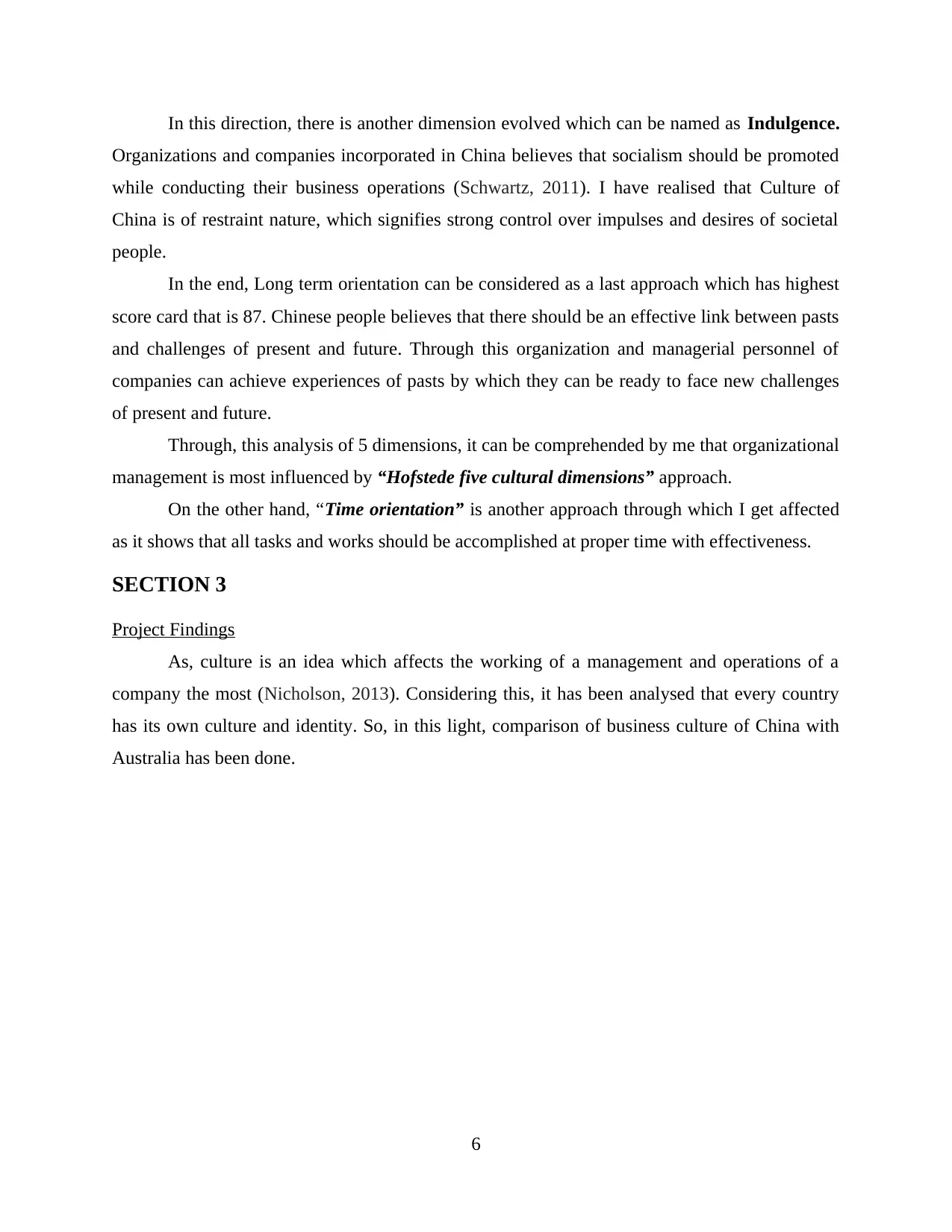
In this direction, there is another dimension evolved which can be named as Indulgence.
Organizations and companies incorporated in China believes that socialism should be promoted
while conducting their business operations (Schwartz, 2011). I have realised that Culture of
China is of restraint nature, which signifies strong control over impulses and desires of societal
people.
In the end, Long term orientation can be considered as a last approach which has highest
score card that is 87. Chinese people believes that there should be an effective link between pasts
and challenges of present and future. Through this organization and managerial personnel of
companies can achieve experiences of pasts by which they can be ready to face new challenges
of present and future.
Through, this analysis of 5 dimensions, it can be comprehended by me that organizational
management is most influenced by “Hofstede five cultural dimensions” approach.
On the other hand, “Time orientation” is another approach through which I get affected
as it shows that all tasks and works should be accomplished at proper time with effectiveness.
SECTION 3
Project Findings
As, culture is an idea which affects the working of a management and operations of a
company the most (Nicholson, 2013). Considering this, it has been analysed that every country
has its own culture and identity. So, in this light, comparison of business culture of China with
Australia has been done.
6
Organizations and companies incorporated in China believes that socialism should be promoted
while conducting their business operations (Schwartz, 2011). I have realised that Culture of
China is of restraint nature, which signifies strong control over impulses and desires of societal
people.
In the end, Long term orientation can be considered as a last approach which has highest
score card that is 87. Chinese people believes that there should be an effective link between pasts
and challenges of present and future. Through this organization and managerial personnel of
companies can achieve experiences of pasts by which they can be ready to face new challenges
of present and future.
Through, this analysis of 5 dimensions, it can be comprehended by me that organizational
management is most influenced by “Hofstede five cultural dimensions” approach.
On the other hand, “Time orientation” is another approach through which I get affected
as it shows that all tasks and works should be accomplished at proper time with effectiveness.
SECTION 3
Project Findings
As, culture is an idea which affects the working of a management and operations of a
company the most (Nicholson, 2013). Considering this, it has been analysed that every country
has its own culture and identity. So, in this light, comparison of business culture of China with
Australia has been done.
6
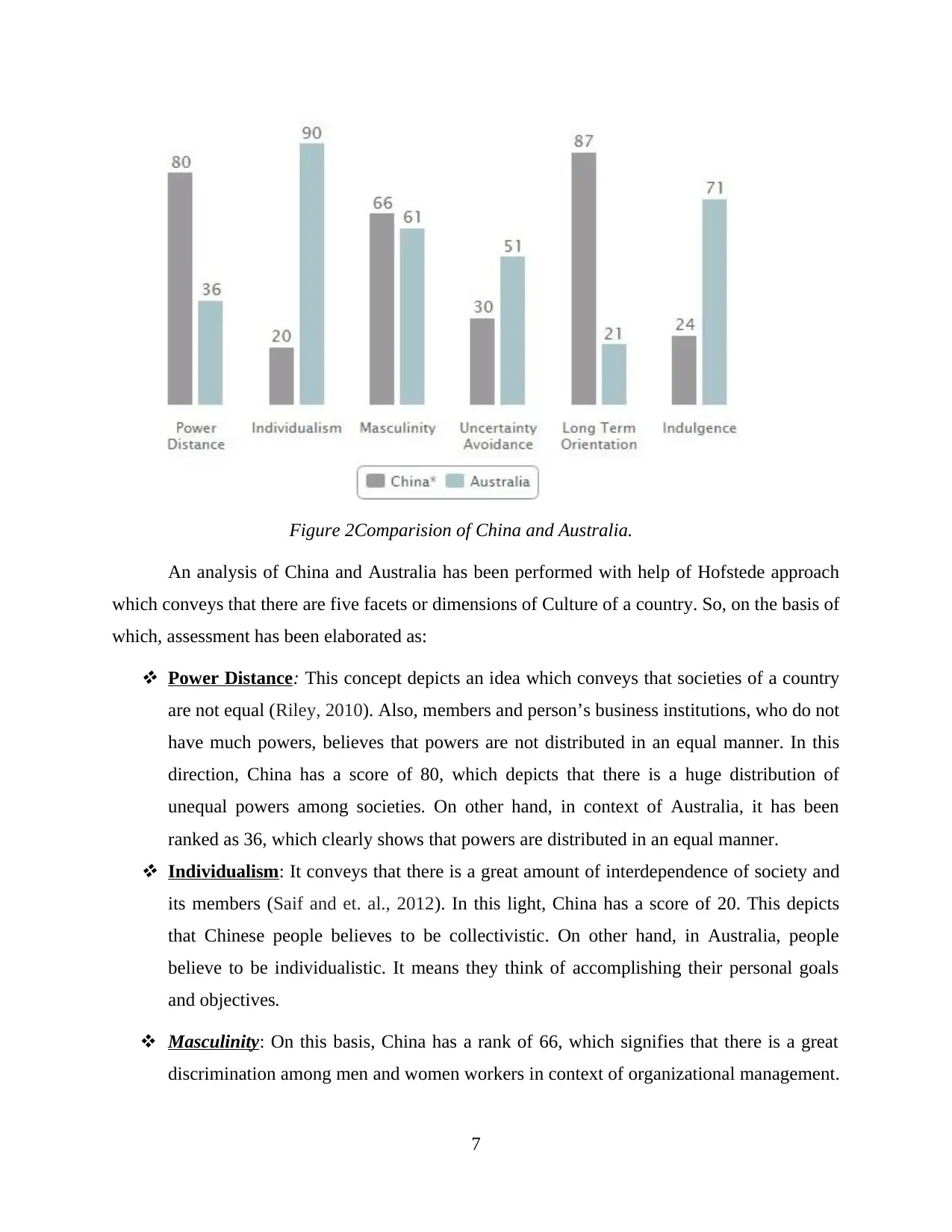
Figure 2Comparision of China and Australia.
An analysis of China and Australia has been performed with help of Hofstede approach
which conveys that there are five facets or dimensions of Culture of a country. So, on the basis of
which, assessment has been elaborated as: Power Distance: This concept depicts an idea which conveys that societies of a country
are not equal (Riley, 2010). Also, members and person’s business institutions, who do not
have much powers, believes that powers are not distributed in an equal manner. In this
direction, China has a score of 80, which depicts that there is a huge distribution of
unequal powers among societies. On other hand, in context of Australia, it has been
ranked as 36, which clearly shows that powers are distributed in an equal manner. Individualism: It conveys that there is a great amount of interdependence of society and
its members (Saif and et. al., 2012). In this light, China has a score of 20. This depicts
that Chinese people believes to be collectivistic. On other hand, in Australia, people
believe to be individualistic. It means they think of accomplishing their personal goals
and objectives.
Masculinity: On this basis, China has a rank of 66, which signifies that there is a great
discrimination among men and women workers in context of organizational management.
7
An analysis of China and Australia has been performed with help of Hofstede approach
which conveys that there are five facets or dimensions of Culture of a country. So, on the basis of
which, assessment has been elaborated as: Power Distance: This concept depicts an idea which conveys that societies of a country
are not equal (Riley, 2010). Also, members and person’s business institutions, who do not
have much powers, believes that powers are not distributed in an equal manner. In this
direction, China has a score of 80, which depicts that there is a huge distribution of
unequal powers among societies. On other hand, in context of Australia, it has been
ranked as 36, which clearly shows that powers are distributed in an equal manner. Individualism: It conveys that there is a great amount of interdependence of society and
its members (Saif and et. al., 2012). In this light, China has a score of 20. This depicts
that Chinese people believes to be collectivistic. On other hand, in Australia, people
believe to be individualistic. It means they think of accomplishing their personal goals
and objectives.
Masculinity: On this basis, China has a rank of 66, which signifies that there is a great
discrimination among men and women workers in context of organizational management.
7
⊘ This is a preview!⊘
Do you want full access?
Subscribe today to unlock all pages.

Trusted by 1+ million students worldwide
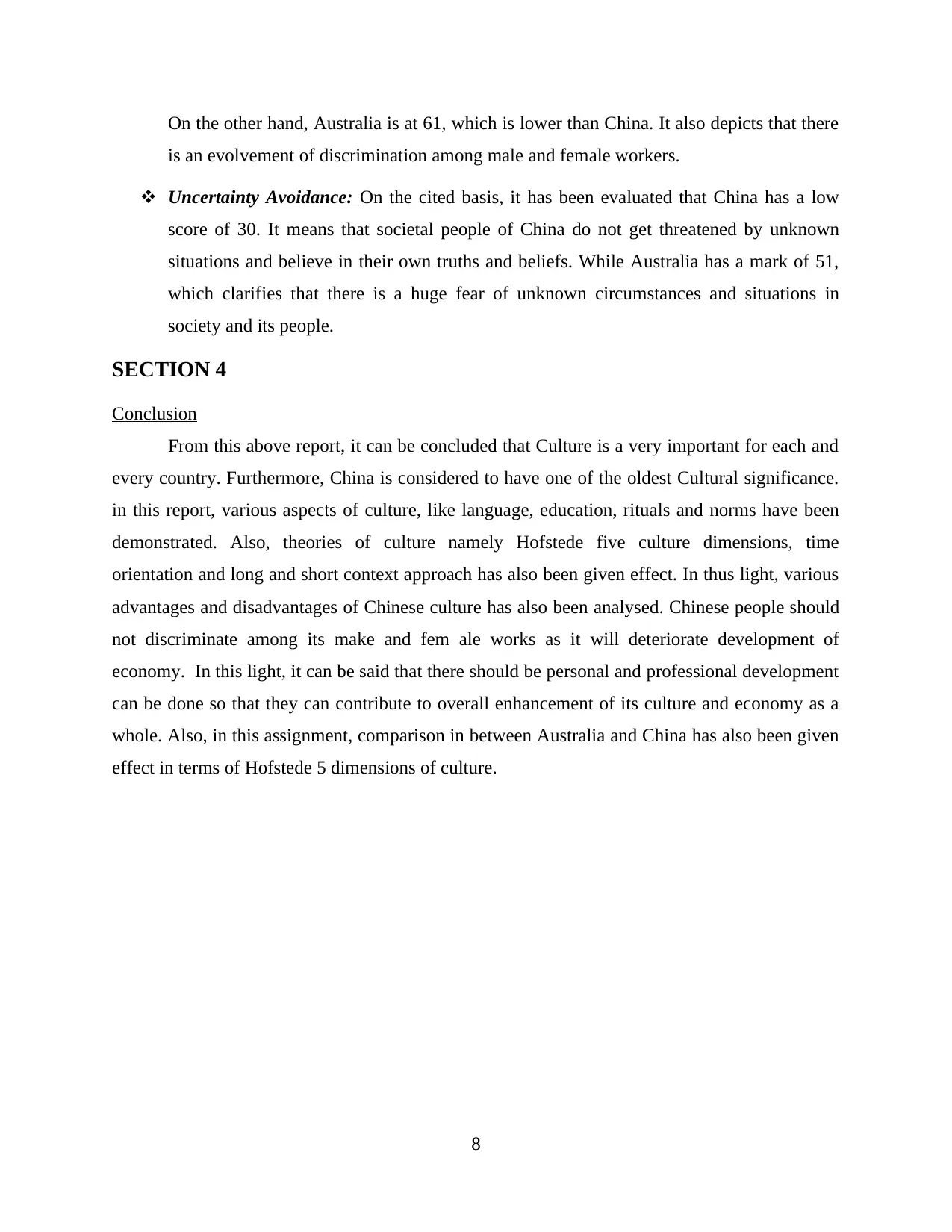
On the other hand, Australia is at 61, which is lower than China. It also depicts that there
is an evolvement of discrimination among male and female workers.
Uncertainty Avoidance: On the cited basis, it has been evaluated that China has a low
score of 30. It means that societal people of China do not get threatened by unknown
situations and believe in their own truths and beliefs. While Australia has a mark of 51,
which clarifies that there is a huge fear of unknown circumstances and situations in
society and its people.
SECTION 4
Conclusion
From this above report, it can be concluded that Culture is a very important for each and
every country. Furthermore, China is considered to have one of the oldest Cultural significance.
in this report, various aspects of culture, like language, education, rituals and norms have been
demonstrated. Also, theories of culture namely Hofstede five culture dimensions, time
orientation and long and short context approach has also been given effect. In thus light, various
advantages and disadvantages of Chinese culture has also been analysed. Chinese people should
not discriminate among its make and fem ale works as it will deteriorate development of
economy. In this light, it can be said that there should be personal and professional development
can be done so that they can contribute to overall enhancement of its culture and economy as a
whole. Also, in this assignment, comparison in between Australia and China has also been given
effect in terms of Hofstede 5 dimensions of culture.
8
is an evolvement of discrimination among male and female workers.
Uncertainty Avoidance: On the cited basis, it has been evaluated that China has a low
score of 30. It means that societal people of China do not get threatened by unknown
situations and believe in their own truths and beliefs. While Australia has a mark of 51,
which clarifies that there is a huge fear of unknown circumstances and situations in
society and its people.
SECTION 4
Conclusion
From this above report, it can be concluded that Culture is a very important for each and
every country. Furthermore, China is considered to have one of the oldest Cultural significance.
in this report, various aspects of culture, like language, education, rituals and norms have been
demonstrated. Also, theories of culture namely Hofstede five culture dimensions, time
orientation and long and short context approach has also been given effect. In thus light, various
advantages and disadvantages of Chinese culture has also been analysed. Chinese people should
not discriminate among its make and fem ale works as it will deteriorate development of
economy. In this light, it can be said that there should be personal and professional development
can be done so that they can contribute to overall enhancement of its culture and economy as a
whole. Also, in this assignment, comparison in between Australia and China has also been given
effect in terms of Hofstede 5 dimensions of culture.
8
Paraphrase This Document
Need a fresh take? Get an instant paraphrase of this document with our AI Paraphraser
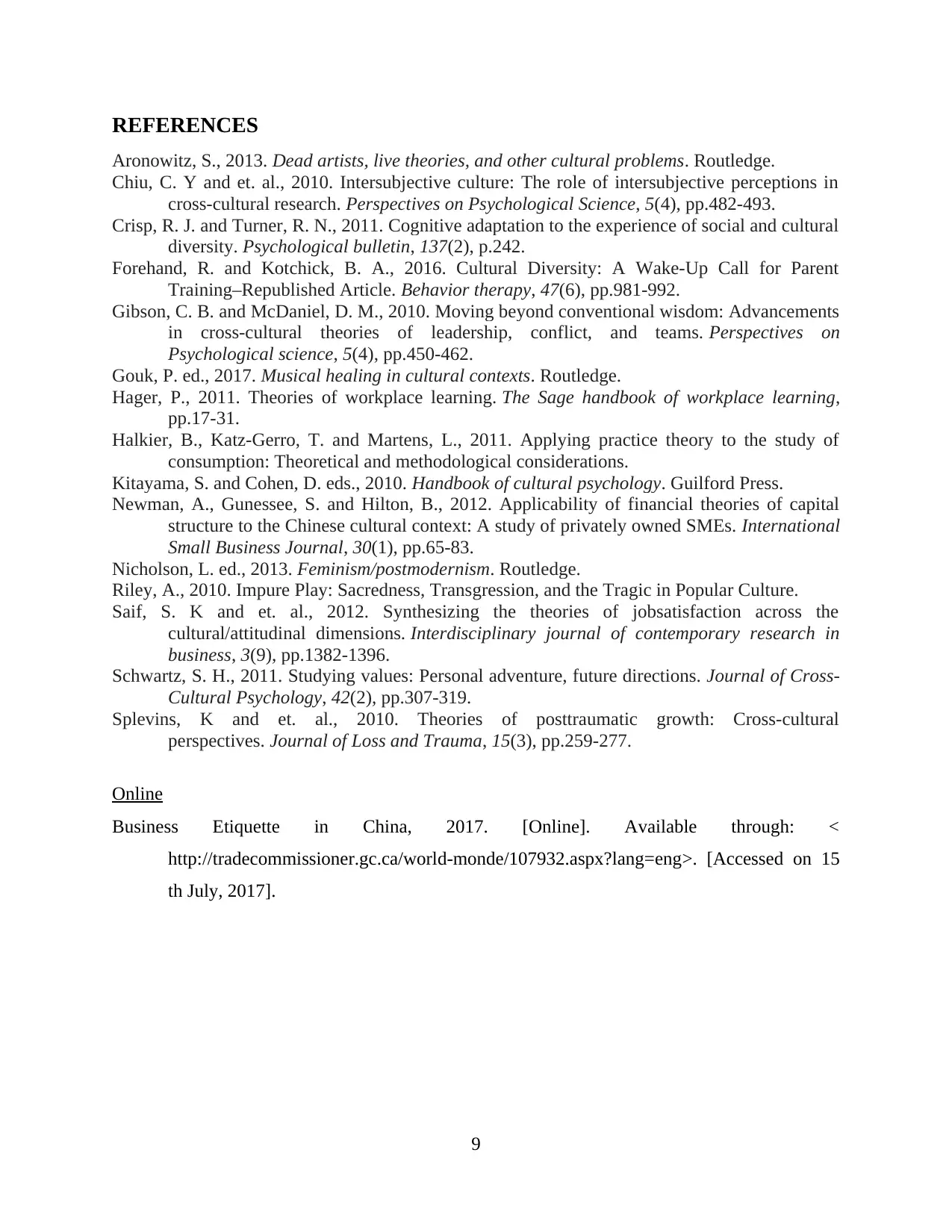
REFERENCES
Aronowitz, S., 2013. Dead artists, live theories, and other cultural problems. Routledge.
Chiu, C. Y and et. al., 2010. Intersubjective culture: The role of intersubjective perceptions in
cross-cultural research. Perspectives on Psychological Science, 5(4), pp.482-493.
Crisp, R. J. and Turner, R. N., 2011. Cognitive adaptation to the experience of social and cultural
diversity. Psychological bulletin, 137(2), p.242.
Forehand, R. and Kotchick, B. A., 2016. Cultural Diversity: A Wake-Up Call for Parent
Training–Republished Article. Behavior therapy, 47(6), pp.981-992.
Gibson, C. B. and McDaniel, D. M., 2010. Moving beyond conventional wisdom: Advancements
in cross-cultural theories of leadership, conflict, and teams. Perspectives on
Psychological science, 5(4), pp.450-462.
Gouk, P. ed., 2017. Musical healing in cultural contexts. Routledge.
Hager, P., 2011. Theories of workplace learning. The Sage handbook of workplace learning,
pp.17-31.
Halkier, B., Katz-Gerro, T. and Martens, L., 2011. Applying practice theory to the study of
consumption: Theoretical and methodological considerations.
Kitayama, S. and Cohen, D. eds., 2010. Handbook of cultural psychology. Guilford Press.
Newman, A., Gunessee, S. and Hilton, B., 2012. Applicability of financial theories of capital
structure to the Chinese cultural context: A study of privately owned SMEs. International
Small Business Journal, 30(1), pp.65-83.
Nicholson, L. ed., 2013. Feminism/postmodernism. Routledge.
Riley, A., 2010. Impure Play: Sacredness, Transgression, and the Tragic in Popular Culture.
Saif, S. K and et. al., 2012. Synthesizing the theories of jobsatisfaction across the
cultural/attitudinal dimensions. Interdisciplinary journal of contemporary research in
business, 3(9), pp.1382-1396.
Schwartz, S. H., 2011. Studying values: Personal adventure, future directions. Journal of Cross-
Cultural Psychology, 42(2), pp.307-319.
Splevins, K and et. al., 2010. Theories of posttraumatic growth: Cross-cultural
perspectives. Journal of Loss and Trauma, 15(3), pp.259-277.
Online
Business Etiquette in China, 2017. [Online]. Available through: <
http://tradecommissioner.gc.ca/world-monde/107932.aspx?lang=eng>. [Accessed on 15
th July, 2017].
9
Aronowitz, S., 2013. Dead artists, live theories, and other cultural problems. Routledge.
Chiu, C. Y and et. al., 2010. Intersubjective culture: The role of intersubjective perceptions in
cross-cultural research. Perspectives on Psychological Science, 5(4), pp.482-493.
Crisp, R. J. and Turner, R. N., 2011. Cognitive adaptation to the experience of social and cultural
diversity. Psychological bulletin, 137(2), p.242.
Forehand, R. and Kotchick, B. A., 2016. Cultural Diversity: A Wake-Up Call for Parent
Training–Republished Article. Behavior therapy, 47(6), pp.981-992.
Gibson, C. B. and McDaniel, D. M., 2010. Moving beyond conventional wisdom: Advancements
in cross-cultural theories of leadership, conflict, and teams. Perspectives on
Psychological science, 5(4), pp.450-462.
Gouk, P. ed., 2017. Musical healing in cultural contexts. Routledge.
Hager, P., 2011. Theories of workplace learning. The Sage handbook of workplace learning,
pp.17-31.
Halkier, B., Katz-Gerro, T. and Martens, L., 2011. Applying practice theory to the study of
consumption: Theoretical and methodological considerations.
Kitayama, S. and Cohen, D. eds., 2010. Handbook of cultural psychology. Guilford Press.
Newman, A., Gunessee, S. and Hilton, B., 2012. Applicability of financial theories of capital
structure to the Chinese cultural context: A study of privately owned SMEs. International
Small Business Journal, 30(1), pp.65-83.
Nicholson, L. ed., 2013. Feminism/postmodernism. Routledge.
Riley, A., 2010. Impure Play: Sacredness, Transgression, and the Tragic in Popular Culture.
Saif, S. K and et. al., 2012. Synthesizing the theories of jobsatisfaction across the
cultural/attitudinal dimensions. Interdisciplinary journal of contemporary research in
business, 3(9), pp.1382-1396.
Schwartz, S. H., 2011. Studying values: Personal adventure, future directions. Journal of Cross-
Cultural Psychology, 42(2), pp.307-319.
Splevins, K and et. al., 2010. Theories of posttraumatic growth: Cross-cultural
perspectives. Journal of Loss and Trauma, 15(3), pp.259-277.
Online
Business Etiquette in China, 2017. [Online]. Available through: <
http://tradecommissioner.gc.ca/world-monde/107932.aspx?lang=eng>. [Accessed on 15
th July, 2017].
9
1 out of 11
Related Documents
Your All-in-One AI-Powered Toolkit for Academic Success.
+13062052269
info@desklib.com
Available 24*7 on WhatsApp / Email
![[object Object]](/_next/static/media/star-bottom.7253800d.svg)
Unlock your academic potential
Copyright © 2020–2025 A2Z Services. All Rights Reserved. Developed and managed by ZUCOL.




